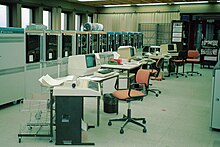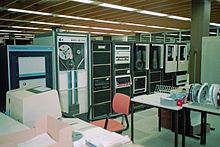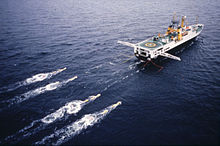Prakla Seismos
| Prakla-Seismos GmbH
|
|
|---|---|
| legal form | GmbH |
| founding | 1963 |
| Seat | Hanover , Germany |
| Number of employees | 1,849 (1985) |
| sales | 408.7 million DM (1985) |
| Branch | Prospecting |
| Website | www.prakla-seismos.de |
Prakla-Seismos (in its own spelling PRAKLA-SEISMOS ) was a global prospecting company and emerged from the merger of two companies. The seismos GmbH for Research on strata and exploitable deposits after the seismic method was on April 4, 1921, Ludger Mintrop in Dortmund founded by five German mining companies supported. The Society for Practical Storage Research GmbH , later Prakla, was founded on March 23, 1937 in Berlin and took over Seismos in 1963. The two companies were merged in Hanover in 1963.
history
Foundation of Seismos
The founder Ludger Mintrop developed the first field-suitable seismograph before and during the First World War . This made it possible to record striking rock boundaries in the depths with great accuracy. This method was originally intended for mining, but gained great importance in this area with the emergence of the oil industry. The hit rate for deep wells had plummeted after the First World War - especially in the United States , the then most important oil country - which caused panic. During the war, the United States provided the Allies with oil almost alone. Now their tanks were pretty empty and the innumerable wells that were sunk were unsuccessful with one exception. They even used methods that the experts found rather suspicious and often enough ridiculed as dowsing.
The mine surveyor and geophysicist Ludger Mintrop announced on December 7, 1919 its patent method for determining the structure of rock layers on. The foundation of the seismos then on April 4, 1921 Mintrop and the mining corporations German Lux , Phoenix , Hoesch , Thyssen and Rhine steel . The aim of the company was to research mountain strata and usable deposits.
Initial work in Germany, Austria , Poland , the Netherlands and Sweden was aimed at recording and delimiting coal deposits as well as ore bodies and quartzite deposits. In order to obtain legible signals, artificial earthquakes had to be created with enormous amounts of explosives. Mintrop developed a completely new process which became known as refraction seismics . Using this method, it was possible to explore the salt domes of Lower Saxony's oil regions and, via this detour, to come across oil.
Breakthrough and crisis of the Seismos

The breakthrough came in 1923: Aguila, a subsidiary of Royal Dutch Shell , brought a survey team to Mexico to drive the Golden Lane oil fields further into new territory. In the same year the Seismos was used in the USA for the Marland Oil Company, which today operates under the name Conoco . Further assignments then followed for Gulf Oil and soon also for Roxana, another Shell subsidiary. On November 19, 1924, the first salt dome in Texas , not far from Houston, was found by a survey team from Seismos for the Gulf Oil . After the flanks of the salt dome had been drilled off, a productive oil field was found.
The find generated a lot of media coverage, which quickly made the search process known. There was talk of a German patent and scientists who had come from Germany and knew how to use a magic drug. Subsequently, Seismos survey teams were also deployed in Egypt , Iraq and Iran .
The monopoly of the Seismos began to crumble after about five years, as Mintrop's methods and instruments, nonetheless patent-protected, were copied. With the onset of the Great Depression in the late twenties the activities were terminated by seismos in America. Germany and Europe did not bring any orders either. Up until then, the intra-European result had never contributed more than five percent to sales. Due to the poor economic situation, many employees had to leave the company.
Reception of the Reich, World War II - Prakla is founded
Shortly thereafter, the situation changed decisively in favor of the company. As part of the so-called Reich survey, the Reich territory was to be geophysically surveyed from 1934: magnetically , gravimetrically and seismically . To measure gravity, SEISMOS GmbH developed the Thyssen gravimeter (named after Stephan Baron von Thyssen) over several years, which was presented in the same year and was awarded the gold medal at the 1937 World Exhibition in Paris. It was the first gravimeter in the world that was built in series (in an edition of around 100 pieces) for use in the field. As a result, various salt domes were discovered in northwestern Germany, which led to new oil and gas deposits. The order situation of the Seismos was secured again and it was possible to find a number of new fields in quick succession, such as Heide in Holstein, Reitbrook near Hamburg, Broistedt and Gifhorn.
During the admission of the Reich, Prakla GmbH was founded on March 23, 1937 and was under strong state influence. Head was Bernhard Brockamp appointed. A former Seismos employee, Friedrich Trappe, took on the task of familiarizing the new society with the seismic method of reflection , which began to dominate in the USA and had surpassed the refraction method. During the Second World War , many exploration teams were deployed in the occupied territories, particularly in Russia.
post war period
The defeat of the German Empire left little of either company. The engineer Waldemar Zettel succeeded in bringing the fragments of the Prakla from Berlin and the Soviet-occupied areas to Lower Saxony and reforming them in Hanover. Both companies experienced the general upswing and expanded their fields of application again worldwide. Before the war, Seismos had already taken over two German geophysics companies, Erda AG and the renowned Exploration with its American branch, Namex , while Prakla took over Elbof . For both societies, this meant expanding their activities into areas that they had previously neglected, such as magnetic, gravimetric and electrical processes.
fusion
The takeover and quasi nationalization of the Seismos by the Prakla in 1963 was a political issue, insofar as the political trend at that time was towards privatization. Ludger Mintrop had already left the Seismos in 1933; the other shareholders had also sold their shares in Thyssen. The Thyssen Group thus became the sole owner of Seismos. The purchase price that Prakla paid for Seismos is said to have been extremely low. Regardless, the merger had created a potent group. The new company became internationally successful.
The rise and fall of society
In the course of rapid development, society endeavored to apply all geophysical methods worldwide, on land, underground, on the water and in the air. In the course of its development, the company has worked in no fewer than 18 European and 29 non-European countries. In addition to crude oil and natural gas, the search was for ores - including uranium - as well as for groundwater and thermal water. In addition, the course of coal seams was explored and the leaching of caverns in salt domes for oil and gas storage was recorded and monitored . All of this was done through the use of applied seismics as well as gravimetric and magnetic measurements. To cope with these tasks, devices, systems and programs were required which the market could not make available or could not make available in the type and quality desired by the company. For this reason, Prakla-Seismos built and developed many things in-house: for example vibrators, mobile drilling rigs of all calibres, devices for precise ship positioning, sea measuring cables, air and water guns. The development of embedded systems and software was also done in-house. Prakla-Seismos also sold these devices, systems and programs to third parties.
Large investments were made during this time. A central company headquarters was set up in Hanover-Lahe and the previously distributed workforce was brought together. The company had its own data center with mainframes. Digital technology and the new vibro-seismic technology were introduced very early on in all sectors . Three oceangoing measuring vessels were built and equipped. In addition, four shallow water measuring vessels for measurements in the coastal area.
In 1972 Prakla-Seismos Geomechanik GmbH was founded in Uetze near Celle . All vibrators and drills for the parent company were developed, built and sold here. An extensive well drilling program in Ghana , Gambia , Guinea-Bissau , Morocco , Senegal and Chad kept parts of geomechanics busy for many years. In Ghana alone, over 3,000 wells have been drilled and set up. The above-ground systems were also built.
In 1985 the GmbH was converted into a stock corporation and an IPO was planned. The permanent staff reached a peak in 1985 with 1,849, but this then fell continuously. For 1988 the annual report showed only 1,417 employees and in mid-1986 the company got into another crisis. The drop in the price of oil had caused the oil companies to drastically reduce exploration costs. Contracts were not renewed, new ones no longer concluded. The plans for an IPO, which had previously also been advocated by the Federal Minister of Finance Gerhard Stoltenberg , who was responsible for the state-owned company , were abandoned.
After further poor results, the company was converted back into a GmbH on April 18, 1991 and shortly afterwards sold to Schlumberger and broken up. The name Seismos was immediately given up. Prakla continued to exist as Geco-Prakla for some time.
Web links
- prakla-bohrtechnik.de
- prakla-seismos.de - website of former employees
- downloadportal.prakla-seismos-report.de - PRAKLA-SEISMOS download portal
- Reflections in the Field. (wmv) Society of Exploration Geophysicists, accessed June 3, 2008 .
Individual evidence
- ↑ History of the Prakla Seismos. prakla-seismos.de, accessed on May 16, 2008 .
- ↑ Parkinson's Method . In: Der Spiegel . No. 21 , 1963 ( online - about the takeover of Seismos by Prakla at the time).
- ^ Announcements 1/2006. (No longer available online.) German Geophysical Society, archived from the original on October 28, 2007 ; Retrieved July 20, 2008 . Info: The archive link was inserted automatically and has not yet been checked. Please check the original and archive link according to the instructions and then remove this notice.
- ↑ Hans Runge. Institute for Petroleum and Natural Gas Technology at Clausthal University of Technology, accessed on May 29, 2008 .
- ↑ H.-J. Bustard: Sixty Years of Applied Geophysics . Prakla-Seismos GmbH, Hanover 1980, p. 5.
- ↑ Oil production: status and prospects. Zeit Online, accessed May 29, 2008 .
- ^ Obituary for Waldemar Zettel, honorary member of the German Geophysical Society. (PDF file; 1.1 MB) (No longer available online.) Dgg-online, archived from the original on December 14, 2007 ; Retrieved May 29, 2008 . Info: The archive link was inserted automatically and has not yet been checked. Please check the original and archive link according to the instructions and then remove this notice.
- ^ Prakla Seismos Report, Marine Exploration. Wolfgang Diehl, accessed on May 29, 2008 .






